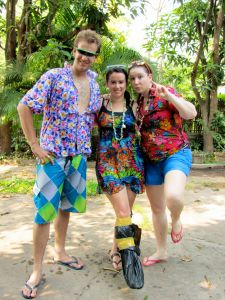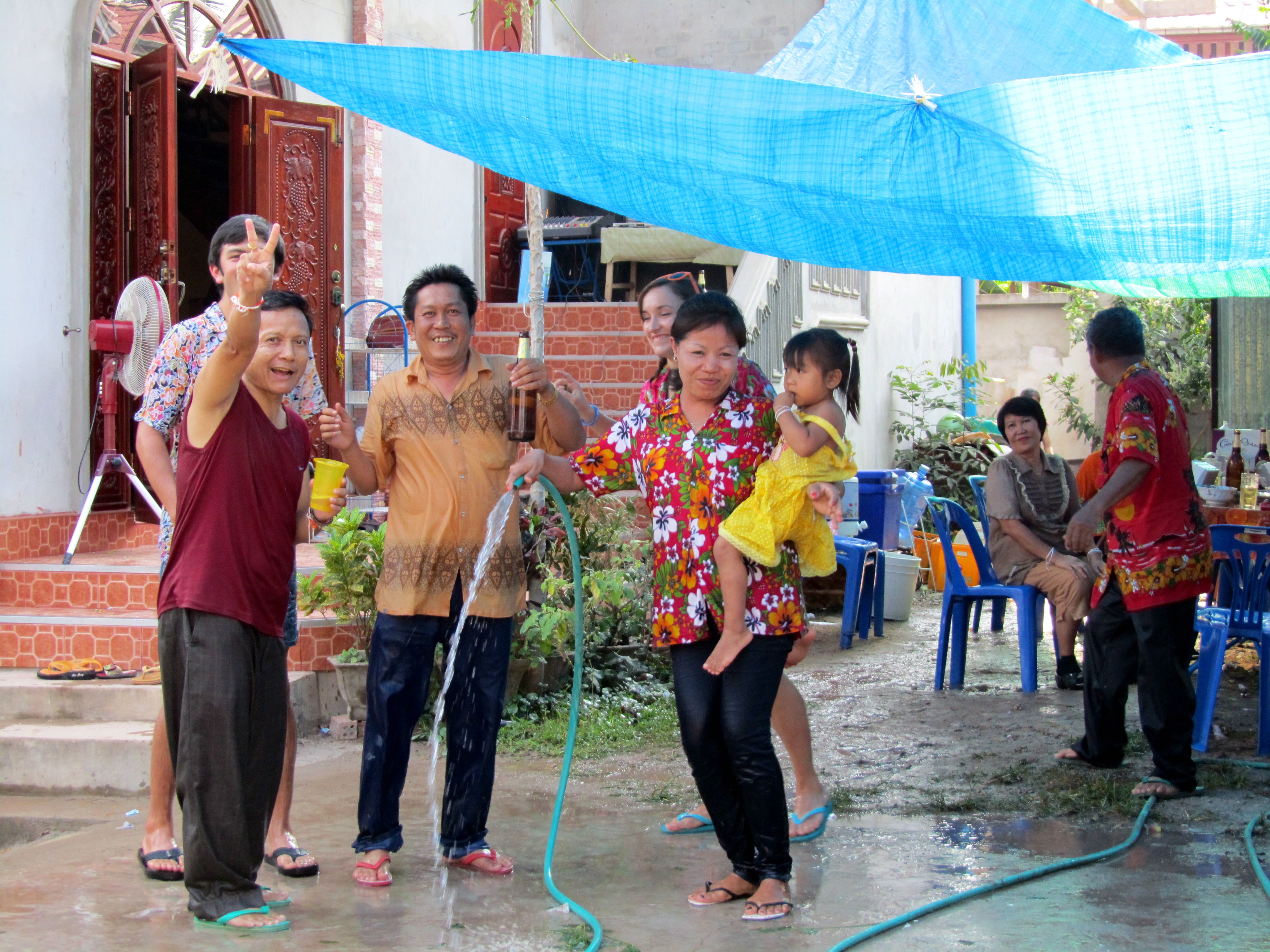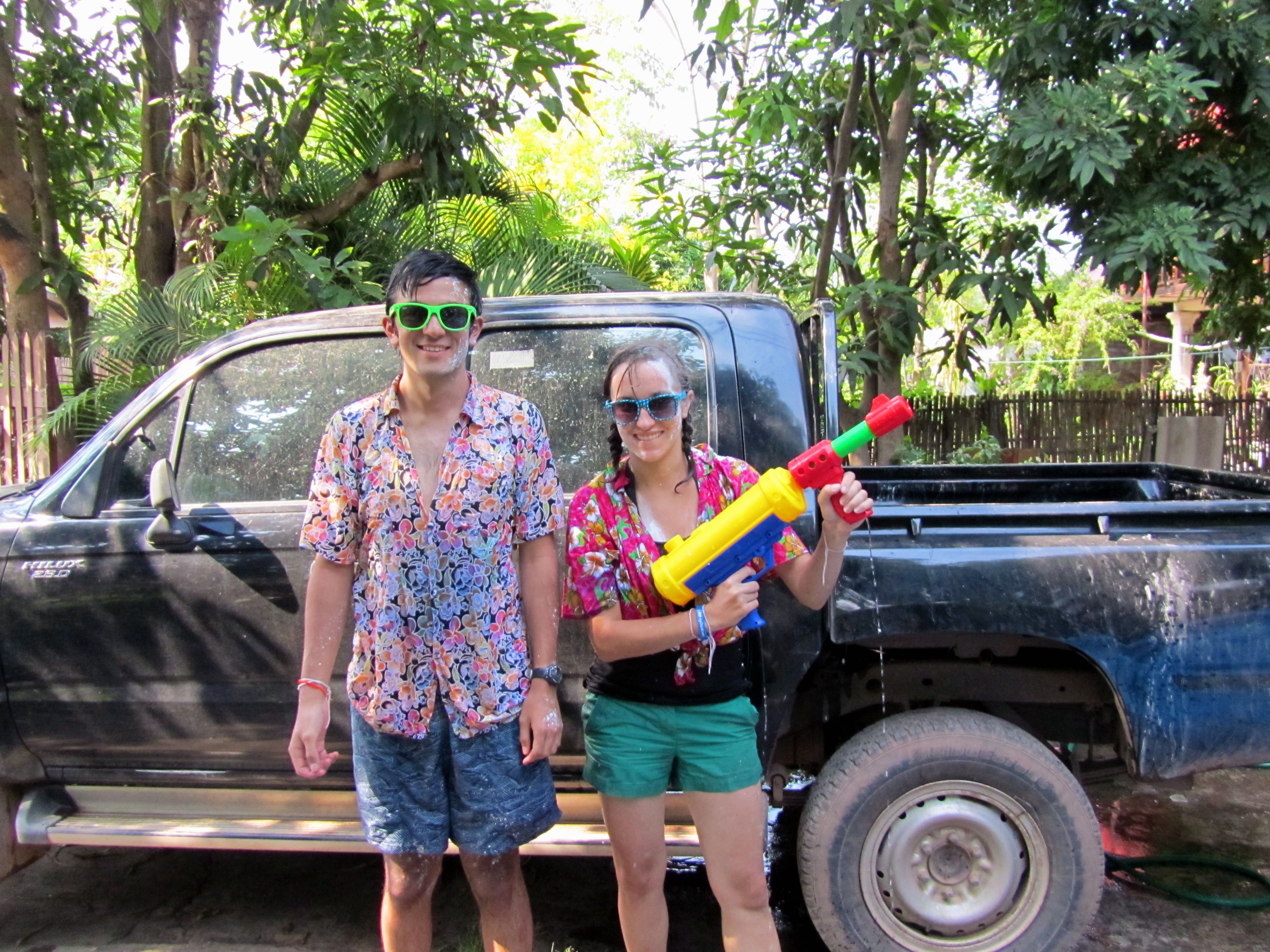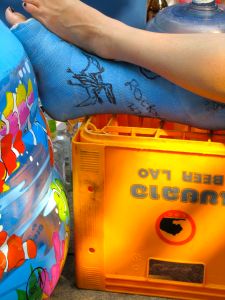As I rode in the old bus from my guesthouse to the airport in Yangon, monks processed, accepting alms, just around the corner from stadium stands of kids waving hoses around and dancing. It was the first day of the Buddhist New Year celebrations that take place every April. In Myanmar, it’s called Thinggyan, while in Thailand, where I passed through on my way back to Vientiane, it’s Songkran. Cambodia has Chaul Chnam Thmey at the same time. Here in Laos, where I returned just in time for the festivities it’s known as Pi Mai, or just literally New Year (pi=year, mai=new).
The holiday, often referred to overall as the “Water Festival,” happens at what is usually the hottest time of year in Laos and other parts of Southeast Asia where it is celebrated. At this time in mid-April, the weather is extremely hot, without the sporadic relief of the rainy season that comes next. Laos celebrates the holiday for three days–the first is the last day of the old year, when people often clean their houses, the second is a middle day, belonging to no year, and the last is the first official day of the new year (this year it’s 2554).
In Laos, the festival traditionally involves visiting temples to make merit (by visiting monks, paying respect to Buddha statues, or freeing small animals), baci ceremonies, visiting relatives, and pouring water on one another to wash away sins and bad luck from the old year and to wish good luck for the new. What many years ago probably began as respectfully and gently splashing water on one another (as some older people still do) is now a full-on, three-day water battle. For Pi Mai, hoses are turned on 24/7, clothes don’t dry for 72 hours, and the Beerlao factory stockpiles a special warehouse of beer months in advance so the country doesn’t run out. Pi Mai is serious business.
The buildup for Pi Mai had been slowly gaining momentum over the previous weeks. Roadside clothing boutiques started displaying all types of obnoxious Hawaiian print shirts (which are inexplicably the Pi Mai uniform). Students were getting antsy for the break–Pi Mai seems to be the almost unanimous favorite Lao holiday. Every time I asked what students were doing for the upcoming break, they inevitably yelled “Lao New Year! Play water!” In Lao, what you do at Pi Mai is lin nam, or literally “play water.” I struggled to figure out what to tell my students would be correct in English–“play with water”? “have water fights”? Now having experienced it, it’s hard to say if there really is a phrase that can encompass what people do at Pi Mai. So “play water” it is.
And play water we did. I touched down back in VTE and a few hours later was sitting in my Australian friends’ yard in a massive kiddie pool that they had pre-purchased, wearing the requisite Hawaiian shirt that I’d picked up from a roadside shop. This first day, we alternated hanging out in their yard and taking short motorbike tours around the neighborhood. During Pi Mai, normally quiet, polite, reserved Lao people go crazy. Outside every house and shop is a party, which trickles out into the street and more often than not involves obscenely loud music (with speakers that miraculously don’t get soaked), and people wearing crazy shirts and hats dancing on chairs and waving around hoses and bottles of beer. It’s quite the spectacle. Anyone who drives past is fair game, so you have to drive very slowly to enjoy the festivities, stopping in front of each house for them to spray you with the hose or pour a bucket of water down your back before continuing.
Day 2 of the holiday began at 7am, when obnoxious, loud Lao traditional music came blasting through the house. The neighbor’s party had started, and nothing would be quiet for the rest of the day. At night, we had a big barbecue to catch up with everyone from school, which at one point evolved into a water fight with some neighborhood kids in the street. Their parents and grandparents dragged a few of us over to their neighboring house for some Beerlao, good luck bracelets, and of course more water.
For the final day, we participated in perhaps the most quintessential of Pi Mai experiences: riding around in a pickup truck. No one really leaves their houses during Pi Mai, except to go to temples, parties or to play water, so the roads are dominated by young people riding slowly around in the back of the ubiquitous Toyota pickups, waging a full-on mobile water battle across the city. The backs of trucks are armed with water guns and buckets of water that are refilled often at roadside shops. Five of us teachers rode around with some Lao friends, their friends and relatives, and kids for four long and exhausting hours. At times, this experience felt like a true battle because we were painfully hit from all sides by water-filled bags thrown by children with shockingly strong arms. Water balloons are not common here, so instead kids fill small plastic bags that are usually used to put sauces in at restaurants with water and food coloring, rubber-band them shut and then chuck them at passersby, hitting their target with maximum pain. In addition to the bags, people throw dye, tapioca balls, and flour, so by the end of the day everyone was covered in a soggy, gelatinous, colorful paste.
While some of the riders were refilling buckets, other people in the truck would stop at the nearest temple, entering with normally inappropriate outfits of shorts and a soaking wet tshirt. Women outside sold buckets of scented water, which is used to sprinkle on the any Buddha images around the temple grounds. Water dripping from the Buddhas was collected to touch the faces of friends as a wish for good luck.
After the whole day in the truck, we were all exhausted. The MVP of Pi Mai award goes without question to my friend Karlee, however, who made it through three crazy and soaking wet days (including the truck ride) with a broken foot, which she had just broke a week earlier in Chiang Mai. The next day, the streets were cleaned and life returned to normal, as if all of the insanity of the holiday hadn’t been real. Hawaiian shirts were put away until next year. Unfortunately all of the photos of water fights from the truck ride were taken on a disposable waterproof camera, and I don’t have digital copies yet. I’ll post a belated set of Pi Mai photos whenever I get those.
Until then, sok dii pi mai der! (Good luck in the new year!)










Pingback: Pi Mai 2555 | Somewhere Near Here.
Pingback: A Realaoszation | From Charlottesville to Indonesia
Pingback: Pi Mai Redux | See Think Explore